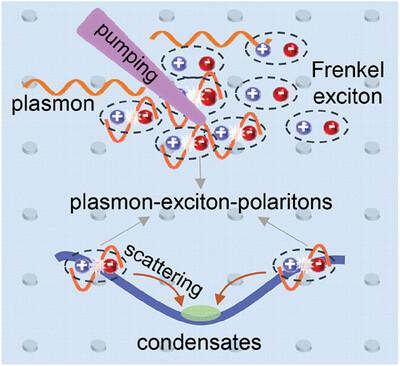当前位置:
X-MOL 学术
›
Laser Photonics Rev.
›
论文详情
Our official English website, www.x-mol.net, welcomes your
feedback! (Note: you will need to create a separate account there.)
Plasmon–Exciton–Polariton Condensation in Organic Semiconductor‐Covered Plasmonic Lattices
Laser & Photonics Reviews ( IF 9.8 ) Pub Date : 2024-11-17 , DOI: 10.1002/lpor.202401308 Shuang Wen, Ang Ren, Haidi Liu, Zhengjun Jiang, Xinyu Dong, Haiyun Dong, Jiannian Yao, Yongli Yan, Yong Sheng Zhao
Laser & Photonics Reviews ( IF 9.8 ) Pub Date : 2024-11-17 , DOI: 10.1002/lpor.202401308 Shuang Wen, Ang Ren, Haidi Liu, Zhengjun Jiang, Xinyu Dong, Haiyun Dong, Jiannian Yao, Yongli Yan, Yong Sheng Zhao

|
Exciton–polariton condensates featuring collective coherence and large nonlinearities are promising for advancing coherent light sources and functional devices. Nevertheless, their reliance on planar cavities with large lateral device footprints and mode volumes hinders device integration. Plasmon–exciton–polaritons (PEPs), arising from the strong coupling between excitons and plasmons, provide an intriguing platform to explore emergent polariton condensation at the nanoscale due to their ultrasmall mode volumes in metal nanoparticles. However, the substantial radiative and Ohmic losses in metals hamper PEPs condensation, particularly in the short wavelength range (<600 nm). Here, a method is proposed to address metal losses by integrating organic semiconductor neat films onto plasmonic lattices. The use of organic semiconductors with large transition dipole moment and low non‐radiation loss enables efficient coupling between massive excitons and lattice plasmons, leading to high‐density PEPs. This ensures a macroscopic number of polaritons populating the low‐lying band edge at relatively low fluences to obtain bosonic stimulation, resulting in PEP condensation. By tailoring the band structures of plasmonic lattices, the condensation of PEPs are further manipulated into different energy states. These findings offer valuable insights for the design of PEP systems and all‐optical polaritonic devices.
中文翻译:

有机半导体覆盖的等离激元-激元-极化激元缩合
激子-极化激元凝聚态具有集体相干性和大非线性,有望用于推进相干光源和功能器件。然而,它们对具有大横向器件占用空间和模式体积的平面腔的依赖阻碍了器件集成。等离激元-激子-极化激元 (PEP) 由激子和等离激元之间的强耦合产生,由于它们在金属纳米颗粒中的超小模式体积,为探索纳米尺度的新兴极化激元凝聚提供了一个有趣的平台。然而,金属中大量的辐射和欧姆损耗阻碍了 PEP 的凝聚,特别是在短波长范围 (<600 nm)。在这里,提出了一种通过将有机半导体整齐薄膜集成到等离子体晶格上来解决金属损耗的方法。使用具有大过渡偶极矩和低非辐射损耗的有机半导体,可以在大质量激子和晶格等离激元之间实现高效耦合,从而实现高密度 PEP。这确保了宏观数量的极化激元以相对较低的磁通量填充低洼带边缘,以获得玻色子刺激,从而导致 PEP 冷凝。通过定制等离激元晶格的能带结构,PEP 的缩合被进一步操纵成不同的能量状态。这些发现为 PEP 系统和全光偏振器器件的设计提供了有价值的见解。
更新日期:2024-11-17
中文翻译:

有机半导体覆盖的等离激元-激元-极化激元缩合
激子-极化激元凝聚态具有集体相干性和大非线性,有望用于推进相干光源和功能器件。然而,它们对具有大横向器件占用空间和模式体积的平面腔的依赖阻碍了器件集成。等离激元-激子-极化激元 (PEP) 由激子和等离激元之间的强耦合产生,由于它们在金属纳米颗粒中的超小模式体积,为探索纳米尺度的新兴极化激元凝聚提供了一个有趣的平台。然而,金属中大量的辐射和欧姆损耗阻碍了 PEP 的凝聚,特别是在短波长范围 (<600 nm)。在这里,提出了一种通过将有机半导体整齐薄膜集成到等离子体晶格上来解决金属损耗的方法。使用具有大过渡偶极矩和低非辐射损耗的有机半导体,可以在大质量激子和晶格等离激元之间实现高效耦合,从而实现高密度 PEP。这确保了宏观数量的极化激元以相对较低的磁通量填充低洼带边缘,以获得玻色子刺激,从而导致 PEP 冷凝。通过定制等离激元晶格的能带结构,PEP 的缩合被进一步操纵成不同的能量状态。这些发现为 PEP 系统和全光偏振器器件的设计提供了有价值的见解。


















































 京公网安备 11010802027423号
京公网安备 11010802027423号